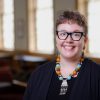This article is more than 5 years old.
In late April, I attended the inaugural Advancing Research Communication & Scholarship (ARCS) conference in Philadelphia. Modeled on the early days of the Charleston Conference, ARCS aimed to be the first conference dedicated to scholarly communication that brought together the key stakeholders in the system: librarians, publishers, authors, and researchers. For two days, the 170 or so attendees gathered for keynotes, concurrent sessions, 24×7 talks, and a reception and poster session to exchange ideas on what works and what does not work in current scholarly communication practices, and to offer suggestions for where we might go in the future.
The opening keynote on Monday morning was extraordinarily fascinating. Will Noel, Penn Libraries Special Collections Center and Director of the Schoenberg Institute for Manuscript Studies, discussed how humanists do have data, they just don’t recognize that they do. To illustrate his point—literally and figuratively—he shared the work that he and others did at The Walter Art Museum in Baltimore on an Archimedes Palimpsest held by the Museum’s special collections. The palimpsest was first identified in 1906 and provided 78 previously unknown Archimedes treatises. He discussed how work on transcribing and saving the Archimedes works has progressed throughout the 20th and 21st centuries, from human eye translation to x-rays to ultraviolet and infrared scans to highlight the Archimedes text for study. The museum has released all of the images throughout the project openly online, and others have built viewers for scholars to be able to study these texts. The images themselves are data, and by making the data openly available, the opportunities for scholars and interested people to engage with this fragile artifact have expanded beyond what would otherwise have been possible had the images been restricted. The entire time he was speaking, I kept wishing that Chelcie, Tanya, Rebecca, Megan, Beth, Craig, and Stephanie could have been in the room with me!
The concurrent sessions I attended throughout the two days were on a variety of scholarly communication topics, many addressing openness and the future of digital scholarship. Points I’m still pondering:
- Do we really know what scholarship is? (One panelist’s answer is that “it’s an event, it’s embodied, it’s materiality”)
- How do we ask where scholarship begins and where does it end?
- How do new forms of scholarship allow us to understand scholarly questions differently?
An insight that struck a chord is that scholarship no longer has to be a fixed form, i.e. a journal article or a monograph, but we haven’t yet developed systems to handle dynamic scholarship, either technically or in our mental framework of scholarship.
One of the best panels I’ve ever heard was at ARCS, bringing together a for-profit publisher, a non-profit library-based publisher, a current PhD student, and a librarian turned consultant. These four individuals, although bringing a variety of perspectives, came to some points of consensus that the model of open access that we have now—particularly looking to publishing—is likely not sustainable in it’s current iteration. Pressure points were identified by all, and while we certainly did not solve the problems of open access publishing, it was encouraging to hear representatives from across the system be able to agree on the challenges and opportunities. It was also refreshing to hear a for-profit publisher publicly acknowledge that publishers are in it for the business, not for advancing scholarship or supporting tenure, and therefore need profit. While this is known to be true, it isn’t always stated quite as bluntly.
The highlight of attending ARCS was the opportunity to connect with many scholarly communication colleagues, and also with several vendors. I shared meals or drinks with colleagues I’ve met through the ACRL Scholarly Communication Roadshow, the ACRL Research & Scholarly Environment Committee, ASERL, the University Intellectual Property Officers group, the ProQuest Dissertations & Theses Advisory Board, and beyond. Because ARCS was a small conference, opportunities for conversations were plentiful, as we weren’t all dashing in different directions to catch shuttles to here, there, and everywhere as is the case at larger conferences (*cough, ALA, cough*).
This current fiscal year, I changed up the conferences I elected to attend, passing on ALA Midwinter and Annual, as well as ACRL, in favor of attending smaller, more focused conferences: Charleston, UIPO, ARCS, and next week, the ASERL Scholarly Communication Unconference. While I may yet return to the larger conferences, given the niche focus of my field, the conferences I’ve attended this year have proven to be a good match for my professional interests and needs, and I anticipate keeping to the smaller conferences for the foreseeable future.

5 Comments on ‘Molly at ARCS’
Palimpsest! Not a word often heard in conversation. What an exciting project-and I love the idea of uncovering information and data that is literally right in front of you but somehow ‘out of view.’ I read with interest about the Archimedes palimpsest and discovered there were 7 ancient texts used to make up that one book.Two of these have not been identified. Amazing! I also read the project manager, Michael Toth is a Wake Forest graduate. Thank you for your report.
Great post! What’s a 24X7 talk?
Craig: Isn’t palimpsest a fun word?! It was such a cool project to hear about.
Carol: Thanks! The 24×7 talks were a series of short talks on a unified theme. Not sure why they were deemed 24×7 talks, though, as there were neither 24 talks for 7 minutes or vice versa!
I thought a 24/7 talk was just something that kept you up all night talking about it, like at summer camp. This sounds like a gIround breaking conference. I’m glad to know these conversations are advancing.
Sounds fascinating! I also like your idea of attending smaller conferences…